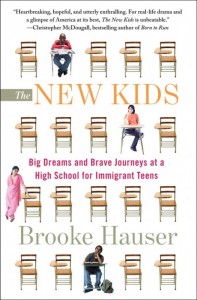
Brooke Hauser. “The New Kids: Big Dreams and Brave Journeys at a High School for Immigrant Teens.” 320 pp. Free Press (2011).
This kaleidoscope of compelling stories is a product of the full year Brooke Hauser spent with students at the International High School at Prospect Heights, Brooklyn. She chronicles their journeys from the first day of the school year to prom and graduation.
The students at the school are The New Kids because the school only accepts students who have been in the United States for less than four years. Members of this diverse group hail from 45 countries and speak 28 languages. In an artful narrative that is both fast-moving and luxuriously detailed, Hauser describes the obstacles the students face as well as their cultures both in New York and in their home countries.
There is Mohamed Bah, a student from Sierra Leone who ran away from his caretakers on the last day of a study trip to the United States, and stayed on. There is Jessica from China, whose father whips up delicacies for her dinner every day but cannot stay and eat with her because he returns to his second wife and two sons. There is Yasmeen from Yemen, who in her senior year is proposed to by her aunt on behalf of her first cousin. As a testament to the intimate relationships she built over the course of her reporting, Hauser gets invited to Yasmeen’s engagement party, a glorious mostly female affair (the groom and a few of Yasmeen’s brothers were the only males) that she attends along with some of the female students and teachers from the school and Yasmeen’s Yemeni relatives and friends.
Even though the book reads like a novel, Hauser expertly weaves in pertinent policy issues. The Senate bill for the DREAM Act was introduced in 2009, and people were still trying to understand its implications as she was writing. The stories she tells stir up empathy for undocumented immigrants. She also addresses the availability of financing for immigrant students applying for college – scholarships, financial aid – which is out of reach for undocumented immigrants.
Another big theme of the book is the teaching of so-called English Language Learners through such techniques as having them act out a new word, or getting them to write in English about their unique cultures and experiences, which Hauser thinks empowers and inspires them. According to Hauser’s website (where you can also read Education Week’s Q&A with her), an English as a Second Language teacher in Aurora, Colo., who read the book designed a curriculum for her class based on the book.
What really shines through in the writing are the students’ shared experiences, such as learning to be American, striving to speak English, and exploring their identities on Facebook. But underneath these are the very personal stories of struggle – struggles to support their siblings or even children, struggles to stay in school and graduate, and struggles to get into and to be able to afford college.
For some of the students, the biggest struggles were in actually getting to the United States. My favorite story was Ngawang’s, even though it was one of the shorter ones. The Tibetan boy spent 24 hours crammed into a suitcase to hide from border authorities as someone took him from the capital of Tibet into India, before he could board a flight to the United States. Hauser writes as if she was there, basing her account on Ngawang’s college essay and interviews.
The book is filled with detail, not just about the students’ lives but also the inspiring teachers and administrators – the people who help the students acclimatize to a new, English-speaking environment and navigate through the school system and New York. For example, the school brings in immigration lawyers to meet with students, the guidance counselor and teachers really spend time with students and sometimes advocate for them to the students’ own parents, and the school arranges internships for the students. Despite caring so much for their students and the hardships they face, the teachers don’t make excuses for them. They want the students to push themselves and succeed.
Sometimes, however, where Hauser tries to slip in short little descriptions of students without really describing their backgrounds, she seems to reinforce cultural stereotypes, making these students appear more like cardboard cutouts than minor characters. But it is understandable with the sheer amount of material she had to work with that she would have had to choose certain students to focus on and not others, while still trying to provide the details that color the story.
In a Q&A at the back of the book, Hauser quotes 60 Minutes creator Don Hewitt: “I don’t do issues – I do stories.” The raw, readable accounts of the New Kids (who by the end of the book feel like familiar friends) paint a picture of the education and immigration systems in America, and of how they serve and exclude immigrant teens.
















